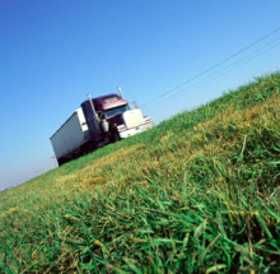Riding Clutch When Braking
Topic 22383 | Page 1

That is a good question for your instructor. There are too many different ways regular drivers can approach a full stop under differing conditions. Do it the way your instructor wants you to.

Coasting with the clutch in or the truck out of gear is a big no-no on the CDL driving exam. You are considered as not being in "100% control" when the truck is essentially free-wheeling.
I usually lug the truck down to 700-800 rpms and then drop 2 gears. Repeat until I'm about to stop and then put the truck in neutral as I'm approaching 5 mpg and come to a stop.
CDL:
Commercial Driver's License (CDL)
A CDL is required to drive any of the following vehicles:
- Any combination of vehicles with a gross combined weight rating (GCWR) of 26,001 or more pounds, providing the gross vehicle weight rating (GVWR) of the vehicle being towed is in excess of 10,000 pounds.
- Any single vehicle with a GVWR of 26,001 or more pounds, or any such vehicle towing another not in excess of 10,000 pounds.
- Any vehicle, regardless of size, designed to transport 16 or more persons, including the driver.
- Any vehicle required by federal regulations to be placarded while transporting hazardous materials.
I just started my driving part of my CDL school and I noticed that I am riding the clutch when coming to a stop, when should apply the clutch when stopping?
Eric are you talking about the road portion or the backing practice? If on the road, follow Chris's advice, though your instructor may have a different view, as Bill noted.
I'm a school instructor for Swift. Many people who drove automatics all their driving lives are unfamiliar with clutches. In the backing practice it's like this: Starting to move: release the BRAKE then CLUTCH. When stopping it's the other way: CLUTCH then BRAKE. Press the clutch all the way to the floor each time. Keep the clutch down all the time until you either go to neutral or start moving again. (Remember to let off smoothly when you begin to move.)
I've had students covering the whole range: from those who start and stop smoothly, to those who forget to push the clutch in at all when they stop.
CDL:
Commercial Driver's License (CDL)
A CDL is required to drive any of the following vehicles:
- Any combination of vehicles with a gross combined weight rating (GCWR) of 26,001 or more pounds, providing the gross vehicle weight rating (GVWR) of the vehicle being towed is in excess of 10,000 pounds.
- Any single vehicle with a GVWR of 26,001 or more pounds, or any such vehicle towing another not in excess of 10,000 pounds.
- Any vehicle, regardless of size, designed to transport 16 or more persons, including the driver.
- Any vehicle required by federal regulations to be placarded while transporting hazardous materials.
HOS:
Hours Of Service
HOS refers to the logbook hours of service regulations.
Eric, as you approach the stop you will want to press the service brake in a manner that you will make a smooth and complete stop before the limit line or crosswalk. As you get closer and closer to the line where you will stop you want to push in the clutch (coasting) so that you only coast about 10, 20 or 30 feet and no more than the length of the tractor and trailer before coming to a smooth and complete stop. If you coast over the length of the tractor and trailer it can be considered coasting out of control. I call this the IN GEAR STOP. HINT: As you get closer and closer to the point where you will push in the clutch you will notice the sound of the engine dropping and getting closer to lugging. Don't let it lug and of course next is killing the truck at a dead stop.
And remember, (at least in the state of Louisiana) if you know you are gonna stop. (Stop sign) you don't have to down shift through all the gears on your way to the stop sign. You can, come to a stop, then drop down to 2nd or 3rd. Just don't coast in neutral for the length of the truck.
Eric, the most important thing is getting clarification from your instructor what he/she wants you to do. Theyre familiar with what the state examiner is looking for. For instance what diver driver is telling you is different than what I was taught in school. When we came to a stop we were allowed to stop in 6th. When we started we were told to start in 4th. The guys who trained me at my company insisted I stop downshifting as I approached a stop sign. The way they do it is just pop it in neutral and rely on service brakes to stop, even if they're in 8th or 9th. Of course I didn't do it their way, I used the stop signs as an opportunity to work on my downshifting. What's important is doing what you gotta do to pass the CDL state exam, then you can form your own methods as long as you remain safe.
Other than that, how is school going for you?
CDL:
Commercial Driver's License (CDL)
A CDL is required to drive any of the following vehicles:
- Any combination of vehicles with a gross combined weight rating (GCWR) of 26,001 or more pounds, providing the gross vehicle weight rating (GVWR) of the vehicle being towed is in excess of 10,000 pounds.
- Any single vehicle with a GVWR of 26,001 or more pounds, or any such vehicle towing another not in excess of 10,000 pounds.
- Any vehicle, regardless of size, designed to transport 16 or more persons, including the driver.
- Any vehicle required by federal regulations to be placarded while transporting hazardous materials.
New Reply:
New! Check out our help videos for a better understanding of our forum features

















Preview:








 TT On Facebook
TT On Facebook
I just started my driving part of my CDL school and I noticed that I am riding the clutch when coming to a stop, when should apply the clutch when stopping?
CDL:
Commercial Driver's License (CDL)
A CDL is required to drive any of the following vehicles: